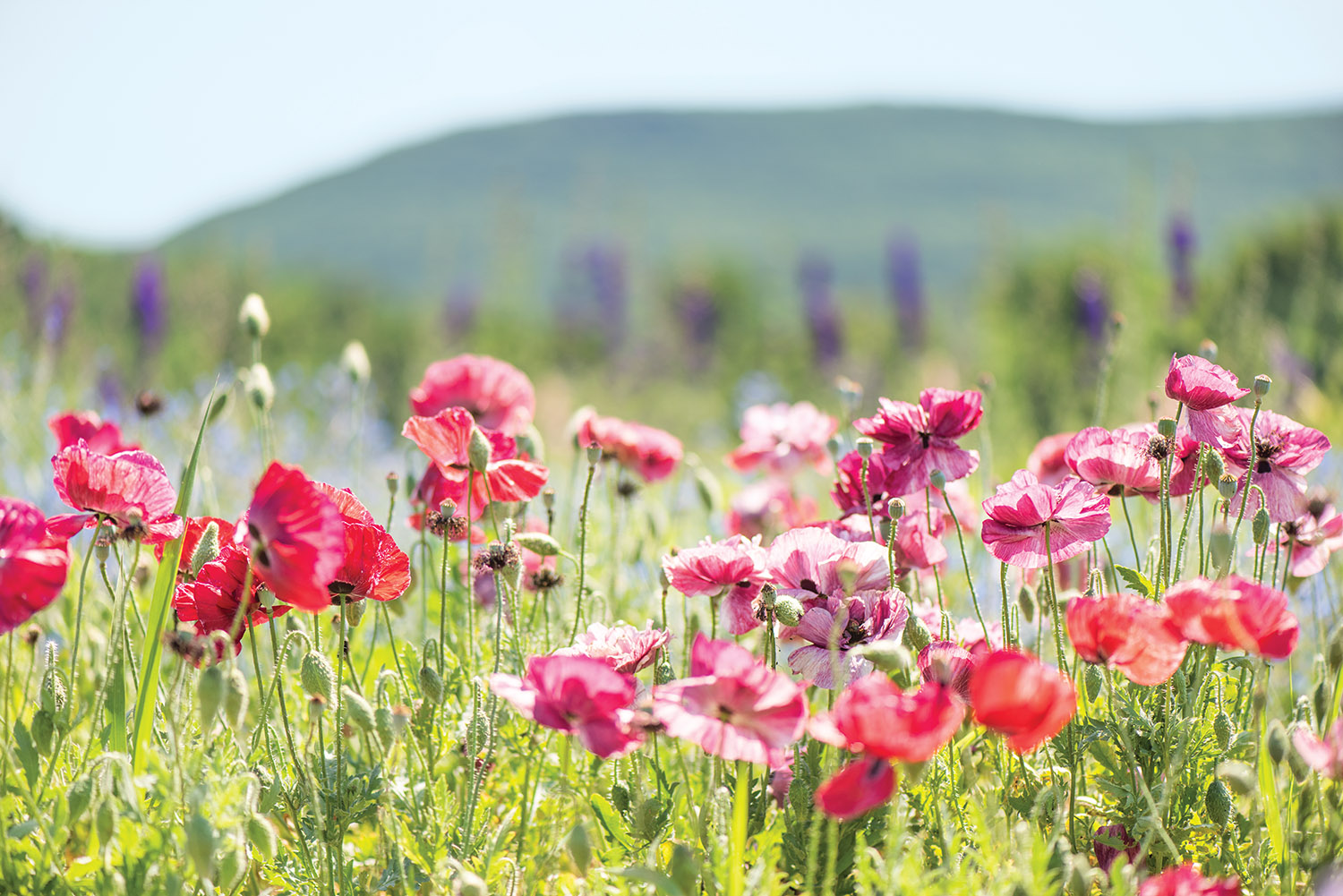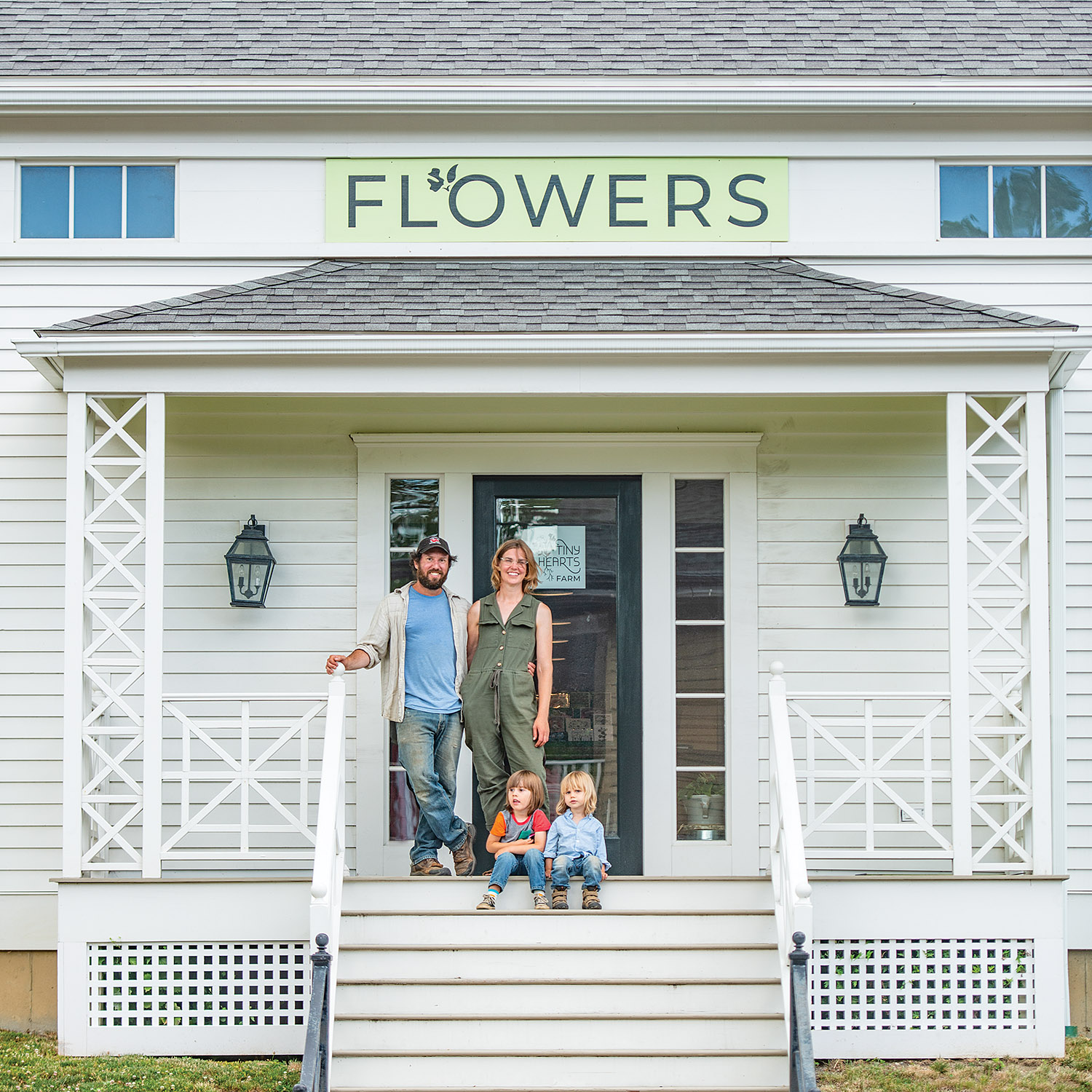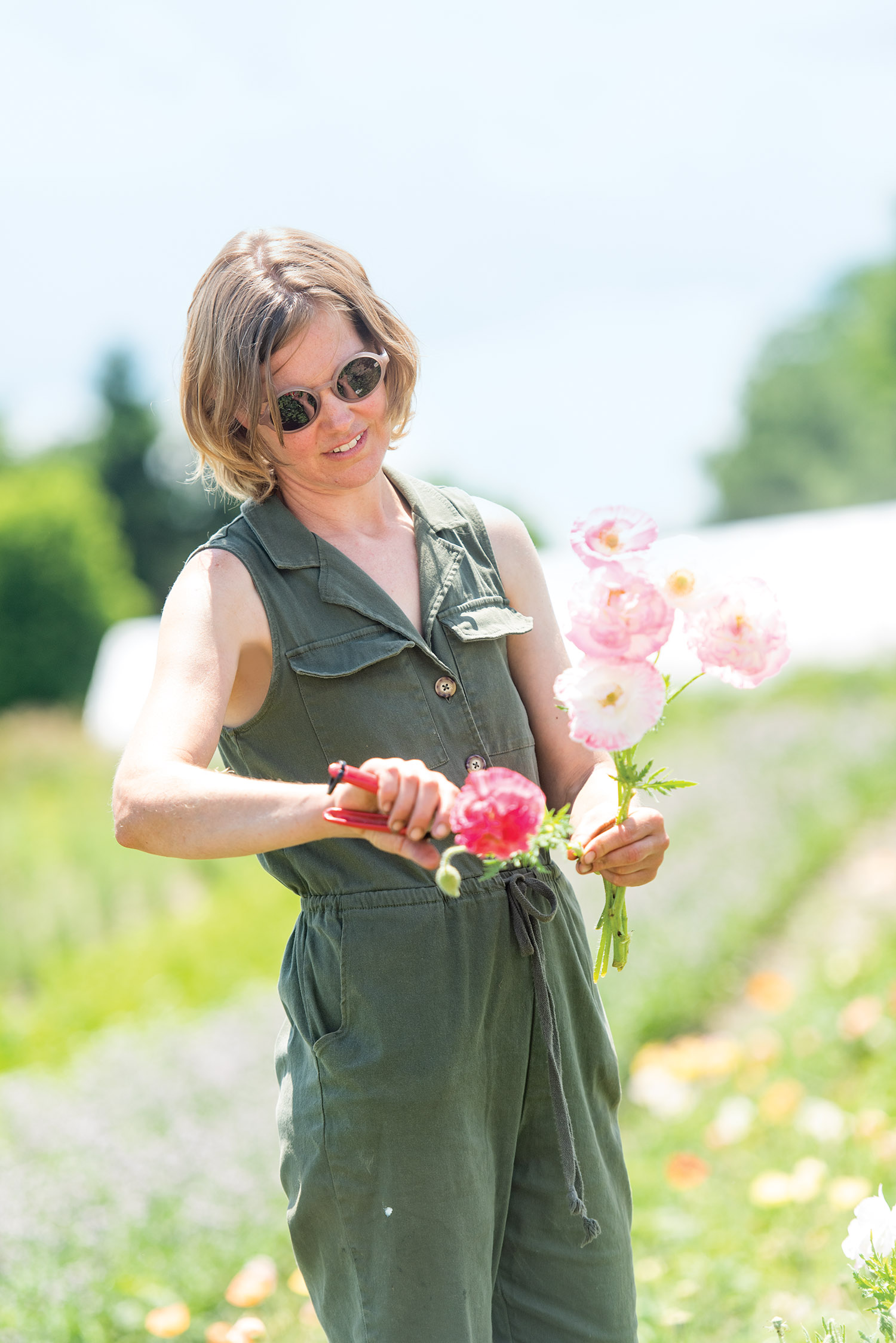
One of the tallest poppies performing in the fields at Tiny Hearts Farm is Shirley poppy ‘Pandora’ with petals that catch the sun’s glow.
Envision a field of Shirley poppies stretching into the distance, creating a patchwork of crinkled, tissue-thin petals swaying on slender stalks. Now, visualize the scene at dawn when all the blooms—each one unique—have been open for hours, preoccupying every type of pollinator imaginable. Place this picture in Upstate New York, about a two-hour drive from New York City, and then imagine waking up to that field of pulsating poppies every late-spring morning for the rest of your life. Now you know why Jenny Elliott grows poppies.

Luke Franco and Jenny Elliott stand in front of their Hillsdale flower shop with their children, George and St. Clair.
Poppies have always fascinated Jenny, even as a child growing up in California. But she also loved music, and for awhile, that seemed to be her career path. She was playing classical guitar and studying music education when she met Luke Franco, a jazz guitarist—and that was the beginning of a scenic detour on her life journey. Together, Jenny and Luke decided to dabble in farming with a focus on food, but it wasn’t long before poppies stepped into the forefront.
Early in her farming foray, Jenny found a plot of land to work with in Upstate New York. However, the land had no potable water source beyond the rainwater she could collect, and it didn’t take Jenny long to realize that growing most vegetables was out of the question. Undeterred, she jumped right over to flower farming as an entirely feasible plan B—and that’s when she remembered the poppies from her youth. She plugged the flowers into the equation, blissfully unaware that she was embarking on a route that most flower farmers would label as “Mission Impossible.” Looking back, Jenny jokes, “It’s amazing where naivete will get you.”

For six weeks, various rows of poppies sparkle in the sun with blocks of beauties such as ‘Mother of Pearl’ (the lighter colors on the left) and ‘Falling in Love’ (Jenny’s favorite workhorse and the first to blossom every year).
With her first packet of ‘Angels Choir’ in hand, Jenny got to work. Germination came readily, and she soon popped her bumper crop of those initial Shirley poppies into the ground. A barrage of phenomenal flowers followed, thriving beautifully with little fuss or irrigation—and Tiny Hearts Farm was born. But then Jenny hit another roadblock. “I couldn’t get the flowers to last as cuts,” she says.
Once again, Jenny was not giving up on her dreams. She knew that with a little homework, she could help her cut flowers thrive. Jenny and Luke moved the farm up to Copake, New York, ambitiously planting 15 acres devoted solely to growing flowers on land where irrigation was possible. Their acreage morphed into 30 acres, and in 2018, they were offered the perfect shop in nearby Hillsdale. In fact, the landlord was so eager to have Tiny Hearts in the location that he custom-fit the renovated interior specifically for them. “The shop was destined for us,” says Jenny.

Much of the prep when cutting Shirley poppies is accomplished in the field, where Jenny strips the leaves to help the stems hydrate.
Even as Tiny Hearts branched out with a variety of flowers, Jenny never stopped planting poppies, with an emphasis on the Shirley poppies, the ones that started it all. Through trial and error, she found that cuts of Shirley poppies could be coaxed to last slightly longer than cuts of lettuce leaf poppies or Oriental poppies. The trick lies in harvesting at just the right moment (at dusk prior to opening, rather than the dawn after the flower popped during the night) and conditioning properly (searing the stems while picking). She also found the right market with event florists in New York City since they do not demand longevity in their cut flowers—they just need arrangements to endure for the day of the fete. Jenny also added ‘Colibri’ Icelandic poppies to her repertoire, with their immense flowers that hold longer than other, more fleeting cousins.
More recently, Tiny Hearts Farm has introduced new color quirks to the Shirley poppy bag of tricks, bringing even more attention to the beloved blooms. The semidouble, smoky, plum-colored ‘Amazing Grey’ now leads sales, but other mixtures are equally poetic, especially maroon-streaked ‘Pandora’, tutu-like ‘Angels Choir’, picotee-edged ‘Mother of Pearl’, and pastel-colored ‘Falling in Love’. With each variety, Jenny and her Tiny Hearts team continue their quest—spreading a little poppy love one bloom at a time.

A cluster of Shirley poppy ‘Angels Choir’ shows the evolution of the flowers from the yellow stamens of a freshly opened flower to the browner stamens of a more mature flower.
Tips from Tiny Hearts
Jenny Elliott could write a book about the challenges of working with poppies as cut flowers. And she has plenty of experience, as she grows 2,400 Shirley poppies and 2,000 Icelandic poppies annually. Seedlings are started as plugs in greenhouse humidity chambers before transplanting the Shirley crop outdoors. That’s the relatively simple part. It’s the handling of the cut flowers that involves a little more skill.
Jenny cuts poppies in the evening when they are on the verge of popping, rather than in the early morning when the flowers have already been open for hours. Then she sears the stems immediately before plunging them into a bucket of water. With the best of care, a cut Shirley poppy can remain prime for three to five days.
Arranging poppies comes easier. The blossoms perch on long, very wiry stems, lending themselves to slender, tube-like bud vases that allow the stem’s posture to become part of the poetry. When composing a more voluptuous arrangement, Jenny says that quantity is the key and suggests bundling them by the dozen. She works with the full poppy spectrum of peaches to reds in each composition, letting the color story become part of her expression. Designing mixed arrangements with other types of flowers is another option when wanting to create structure. However, Jenny cautions against mixing in flowers that might upstage the poppies size-wise. She likes choosing borage, larkspur, nigella, feverfew, strawflowers, sweet Williams, or cornflowers of modest dimensions to mingle with her poppies. As this poppy-lover says, “The result is always breathtaking.”
By Tovah Martin | Photography by Kindra Clineff



